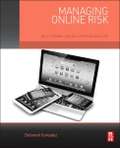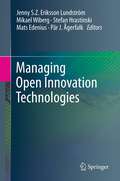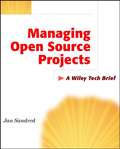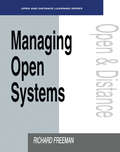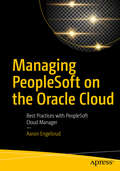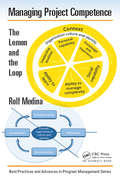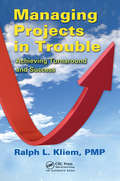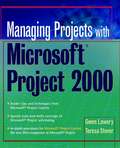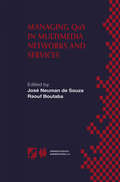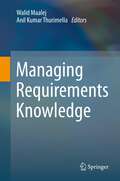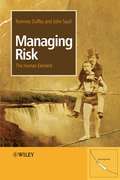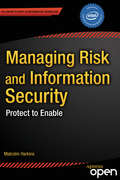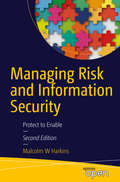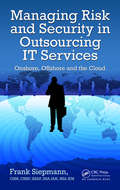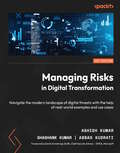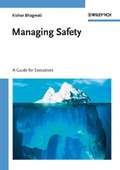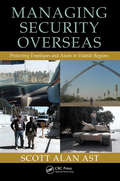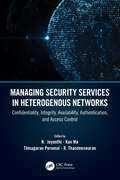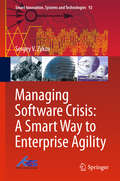- Table View
- List View
Managing Online Risk: Apps, Mobile, and Social Media Security
by Deborah GonzalezIn recent years, building a corporate online presence has become nonnegotiable for businesses, as consumers expect to connect with them in as many ways as possible. There are benefits to companies that use online technology, but there are risks as well. Managing Online Risk presents the tools and resources needed to better understand the security and reputational risks of online and digital activity, and how to mitigate those risks to minimize potential losses. Managing Online Risk highlights security and risk management best practices that address concerns such as data collection and storage, liability, recruitment, employee communications, compliance violations, security of devices (in contexts like mobile, apps, and cloud computing), and more. Additionally, this book offers a companion website that was developed in parallel with the book and includes the latest updates and resources for topics covered in the book.Explores the risks associated with online and digital activity and covers the latest technologies, such as social media and mobile devicesIncludes interviews with risk management experts and company executives, case studies, checklists, and policy samplesA website with related content and updates (including video) is also available
Managing Open Innovation Technologies
by Jenny S. Z. Eriksson Lundström, Mikael Wiberg, Stefan Hrastinski, Mats Edenius and Pär J. ÅgerfalkOpen innovation increases the profit of companies and organizations via the input and the adoption of new ideas that are transformed into new processes, products, and services. Yet, how do we ensure that adopters of such innovations focus on relevant problems and use appropriate methods? How should we manage open innovation technologies? How can we exploit distributed knowledge and inventions? And how can we promote them successfully on the market? With valuable lessons to be learned from academic research and industrial experiences of e.g. Intel, Nokia, Philips Healthcare, small municipalities, e-learning platforms and user communities, this book focuses on some of the key dimensions of open innovation and open innovation technologies. It is divided into three themes: theme 1 deals with open innovation as it is in use today, including theoretical underpinnings and lessons from related research fields. Theme 2 analyzes the use of open innovation in organizations today in order to extract best practices. Theme 3 presents forward-looking theoretical research as well as practical future uses of open innovation. Each chapter addresses the particular topics by presenting experiences and results gained in real life projects and/or by empirical research, and clearly states its purpose and how readers are supposed to benefit from it. Overall, the objectives of this book are to advance and disseminate research on systematic open innovation, and to make its results available to practitioners. Thus, the intended target audience includes the international academic community, industrial enterprises, and public authorities.
Managing Open Source Projects: A Wiley Tech Brief (Technology Briefs Series #18)
by Jan SandredThe only guide to managing and integrating the open source model With the phenomenal success of Linux, companies are taking open source business solutions much more seriously than ever before. This book helps to satisfy the growing demand for guidance on how to manage open source enterprise development projects. Expert Jan Sandred explores the open source philosophy, describes current software tools for managing open source projects, and provides expert guidance on how to organize and manage open source projects using the Internet as a collaboration tool. With the help of several fascinating and instructive case studies, Sandred explores practical concerns such as building, motivating, and managing virtual teams; structuring tasks and meeting deadlines; establishing trust; project management software tools; maintaining project security; and more.
Managing Open Systems (Open and Flexible Learning Series)
by Freeman, RichardThe author of this text concentrates on the management and support systems needed in open and distance learning, to help the reader decide whether an open learning system is appropriate for their given situation.
Managing Open Systems (Open and Flexible Learning Series)
by Freeman, RichardThe author of this text concentrates on the management and support systems needed in open and distance learning, to help the reader decide whether an open learning system is appropriate for their given situation.
Managing PeopleSoft on the Oracle Cloud: Best Practices with PeopleSoft Cloud Manager
by Aaron EngelsrudTransition from hosting your PeopleSoft applications in a traditional, on-premises data center to hosting those same applications in the Oracle Cloud infrastructure. This functional and technical book helps you install and support PeopleSoft Cloud Manager and makes the case for moving applications to the Oracle Cloud technology stack. You will learn about the use and cost of PeopleSoft instances in the cloud and how to configure your PeopleSoft environments to take advantage of the Oracle Cloud platform. Managing PeopleSoft on the Oracle Cloud is a resource for the functional analyst or IT manager tasked with moving PeopleSoft to the Oracle Cloud, as well as for the PeopleSoft system administrator or developer tasked with keeping a PeopleSoft installation running smoothly. Multiple cloud use cases illustrate PeopleSoft system configuration best practices, spell out specific requirements for running PeopleSoft Cloud Manager on the Oracle Cloud, and outline tips and tricks for running PeopleSoft instances in the cloud.What You'll LearnInstall and configure PeopleSoft Cloud ManagerSubscribe to maintenance releases and updatesCreate new topologies and build new environment templatesInstantiate and manage PeopleSoft instances using Cloud ManagerTransition PeopleSoft from on site to in the cloudWho This Book Is ForTechnical PeopleSoft administrators looking for best practices, tips, and tricks for moving PeopleSoft to the Oracle Cloud, as well as for IT managers building a case for such a move. The book is an excellent choice for both functional and technical teams who are just starting out on their PeopleSoft cloud journey.
Managing Project Competence: The Lemon and the Loop (Best Practices in Portfolio, Program, and Project Management)
by Rolf MedinaFor companies to be successful, the management of an organization needs to understand how competence evolves and how it can be utilized and linked to the organization’s goals. When executive managers understand this, there is a higher probability that the people working in the organization will be more satisfied with their working situation. Satisfaction increases because competence will likely be central in the organization, with focus on motivating people to develop new competence, healthy internal mobility, and organizational learning. Positively managing competence in most cases leads to a win–win situation for the company and the individual. This book describes how we as individuals, as well as organizations, can be efficient in the development and utilization of competence. It takes two perspectives of competence and connects them in a project-intensive and knowledge-intensive context. The first perspective is the "Lemon," which focuses on individual competence and the role of organizational culture. The Lemon framework takes the concept of competence based on knowledge and experience and explains how a person can apply knowledge and experience to different contexts. It changes the concept of competence from being static to being agile and dynamic. The second perspective of competence is the "Loop," which models how organizations can manage not only to the benefit of organizational strategies and goals but also to an individual’s future career. The Lemon and the Loop are the basic tools to make competence and performance management agile and effective. This book presents practical ways to acquire new knowledge and skills. One method is REPI (Reflection, Elaboration, Practicing/Participation, and Investigation), which can be used for training, coaching, competence development, agile performance management, and much more. Readers of the book are given new insight into the concept of competence and how both people and organizations can be more competitive, innovative, and open to learning. In addition, the readers get practical tools and advice on how to act in different situations to manage both organizational and individual learning. Managing Project Competence: The Lemon and the Loop breaks old views of looking at competence and brings competence into the knowledge-intensive age.
Managing Project Competence: The Lemon and the Loop (Best Practices in Portfolio, Program, and Project Management)
by Rolf MedinaFor companies to be successful, the management of an organization needs to understand how competence evolves and how it can be utilized and linked to the organization’s goals. When executive managers understand this, there is a higher probability that the people working in the organization will be more satisfied with their working situation. Satisfaction increases because competence will likely be central in the organization, with focus on motivating people to develop new competence, healthy internal mobility, and organizational learning. Positively managing competence in most cases leads to a win–win situation for the company and the individual. This book describes how we as individuals, as well as organizations, can be efficient in the development and utilization of competence. It takes two perspectives of competence and connects them in a project-intensive and knowledge-intensive context. The first perspective is the "Lemon," which focuses on individual competence and the role of organizational culture. The Lemon framework takes the concept of competence based on knowledge and experience and explains how a person can apply knowledge and experience to different contexts. It changes the concept of competence from being static to being agile and dynamic. The second perspective of competence is the "Loop," which models how organizations can manage not only to the benefit of organizational strategies and goals but also to an individual’s future career. The Lemon and the Loop are the basic tools to make competence and performance management agile and effective. This book presents practical ways to acquire new knowledge and skills. One method is REPI (Reflection, Elaboration, Practicing/Participation, and Investigation), which can be used for training, coaching, competence development, agile performance management, and much more. Readers of the book are given new insight into the concept of competence and how both people and organizations can be more competitive, innovative, and open to learning. In addition, the readers get practical tools and advice on how to act in different situations to manage both organizational and individual learning. Managing Project Competence: The Lemon and the Loop breaks old views of looking at competence and brings competence into the knowledge-intensive age.
Managing Projects in Trouble: Achieving Turnaround and Success (Systems Innovation Book Ser.)
by PMP, Ralph KliemWhether you use budget, schedule, quality, or other criteria, the statistics by think tanks, institutes, associations, and other trade organizations all point to one inescapable conclusion: your project has a greater chance of getting into trouble than staying out of it.Based on the lessons learned by the author during a quarter of a century of lea
Managing Projects in Trouble: Achieving Turnaround and Success
by PMP, Ralph KliemWhether you use budget, schedule, quality, or other criteria, the statistics by think tanks, institutes, associations, and other trade organizations all point to one inescapable conclusion: your project has a greater chance of getting into trouble than staying out of it.Based on the lessons learned by the author during a quarter of a century of lea
Managing Projects With Microsoft Project 2000: For Windows
by Gwen Lowery Teresa StoverLearn proven project management strategies as you master the world's #1 project management software Here's a winning combination: a series of successful project management strategies that cover every phase of the process AND an insider's guide to the most powerful and versatile project management software available anywhere. That's what you'll find in Managing Projects with Microsoft Project 2000. A synchronized learning system helps you get with the program Microsoft Project 2000 brings 21st-century power to this already formidable tool. Whether you're an experienced user preparing to upgrade to Microsoft Project 2000 or an aspiring project manager who needs to understand the big picture as you gain control of the details, this remarkable one-stop guide helps you make the most of this outstanding new program. It puts you in control of every new feature and enhanced capability, including how to: SCHEDULE TASKS AND TRACK PROGRESS using task calendars, deadline dates, estimated durations, baseline and interim plans, and more MANAGE RESOURCES FOR BETTER TASK SCHEDULING with new methods that let you vary resource availability, specify material resources, and set task priorities for resource leveling MODEL PROJECTS GRAPHICALLY WITH NETWORK DIAGRAM VIEW, which offers flexible viewing and formatting of program information in a graphical layout of tasks MANAGE TASKS AND RESOURCES ACROSS A WORKGROUP with Microsoft Project Central-a Web-based companion to Microsoft Project 2000 that allows for task delegation up and down organizational lines, task progress reporting, and narrative status reporting WORK FASTER AND SMARTER by jump-starting new products with templates, grouping tasks and resources, creating your own work breakdown structure numbering scheme-and much, much more
Managing QoS in Multimedia Networks and Services: IEEE / IFIP TC6 — WG6.4 & WG6.6 Third International Conference on Management of Multimedia Networks and Services (MMNS’2000) September 25–28, 2000, Fortaleza, Ceará, Brazil (IFIP Advances in Information and Communication Technology #54)
by José Neuman De Souza Raouf BoutabaWelcome to the third International Conference on Management of Multimedia Networks and Services (MMNS'2000) in Fortaleza (Brazil)! The first MMNS was held in Montreal ( Canada) in july 1997 and the second MMNS was held in Versailles (France) in November 1998. The MMNS conference takes place every year and a half and is aimed to be a truly international event by bringing together researchers and practitioners from all around the world and by organising the conference each time in a different continent/country. Over the past several years, there has been a considerable amount of research within the fields of multimedia networking and network management. Much of that work has taken place within the context of managing Quality-of Service in broadband integrated services digital networks such as the A TM, and more recently in IP-based networks, to respond to the requirements of emerging multimedia applications. A TM networks were designed to support multimedia traffic with diverse characteristics and can be used as the transfer mode for both wired and wireless networks. A new set of Internet protocols is being developed to provide better quality of service, which is a prerequisite for supporting multimedia applications. Multimedia applications have a different set of requirements, which impacts the design of the underlying communication network as well as its management. Several QoS management mechanisms intervening at different layers of the communication network are required including QoS-routing, QoS-based transport, QoS negotiation, QoS adaptation, FCAPS management, and mobility management.
Managing Requirements Knowledge
by Walid Maalej and Anil Kumar ThurimellaRequirements engineering is one of the most complex and at the same time most crucial aspects of software engineering. It typically involves different stakeholders with different backgrounds. Constant changes in both the problem and the solution domain make the work of the stakeholders extremely dynamic. New problems are discovered, additional information is needed, alternative solutions are proposed, several options are evaluated, and new hands-on experience is gained on a daily basis. The knowledge needed to define and implement requirements is immense, often interdisciplinary and constantly expanding. It typically includes engineering, management and collaboration information, as well as psychological aspects and best practices.This book discusses systematic means for managing requirements knowledge and its owners as valuable assets. It focuses on potentials and benefits of “lightweight,” modern knowledge technologies such as semantic Wikis, machine learning, and recommender systems applied to requirements engineering. The 17 chapters are authored by some of the most renowned researchers in the field, distilling the discussions held over the last five years at the MARK workshop series. They present novel ideas, emerging methodologies, frameworks, tools and key industrial experience in capturing, representing, sharing, and reusing knowledge in requirements engineering.While the book primarily addresses researchers and graduate students, practitioners will also benefit from the reports and approaches presented in this comprehensive work.
Managing Risk: The Human Element
by Romney Beecher Duffey John Walton SaullThe human element is the principle cause of incidents and accidents in all technology industries; hence it is evident that an understanding of the interaction between humans and technology is crucial to the effective management of risk. Despite this, no tested model that explicitly and quantitatively includes the human element in risk prediction is currently available. Managing Risk: the Human Element combines descriptive and explanatory text with theoretical and mathematical analysis, offering important new concepts that can be used to improve the management of risk, trend analysis and prediction, and hence affect the accident rate in technological industries. It uses examples of major accidents to identify common causal factors, or “echoes”, and argues that the use of specific experience parameters for each particular industry is vital to achieving a minimum error rate as defined by mathematical prediction. New ideas for the perception, calculation and prediction of risk are introduced, and safety management is covered in depth, including for rare events and “unknown” outcomes Discusses applications to multiple industries including nuclear, aviation, medical, shipping, chemical, industrial, railway, offshore oil and gas; Shows consistency between learning for large systems and technologies with the psychological models of learning from error correction at the personal level; Offers the expertise of key leading industry figures involved in safety work in the civil aviation and nuclear engineering industries; Incorporates numerous fascinating case studies of key technological accidents. Managing Risk: the Human Element is an essential read for professional safety experts, human reliability experts and engineers in all technological industries, as well as risk analysts, corporate managers and statistical analysts. It is also of interest to professors, researchers and postgraduate students of reliability and safety engineering, and to experts in human performance. “…congratulations on what appears to be, at a high level of review, a significant contribution to the literature…I have found much to be admired in (your) research” Mr. Joseph Fragola – Vice President of Valador Inc. “The book is not only technically informative, but also attractive to all concerned readers and easy to be comprehended at various level of educational background. It is truly an excellent book ever written for the safety risk managers and analysis professionals in the engineering community, especially in the high reliability organizations…” Dr Feng Hsu, Head of Risk Assessment and Management, NASA Goddard Space Flight Center “I admire your courage in confronting your theoretical ideas with such diverse, ecologically valid data, and your success in capturing a major trend in them….I should add that I find all this quite inspiring . …The idea that you need to find the right measure of accumulated experience and not just routinely used calendar time makes so much sense that it comes as a shock to realize that this is a new idea”, Professor Stellan Ohlsson, Professor of Psychology, University of Illinois at Chicago
Managing Risk and Information Security: Protect to Enable
by Malcolm HarkinsManaging Risk and Information Security: Protect to Enable, an ApressOpen title, describes the changing risk environment and why a fresh approach to information security is needed. Because almost every aspect of an enterprise is now dependent on technology, the focus of IT security must shift from locking down assets to enabling the business while managing and surviving risk. This compact book discusses business risk from a broader perspective, including privacy and regulatory considerations. It describes the increasing number of threats and vulnerabilities, but also offers strategies for developing solutions. These include discussions of how enterprises can take advantage of new and emerging technologies—such as social media and the huge proliferation of Internet-enabled devices—while minimizing risk. With ApressOpen, content is freely available through multiple online distribution channels and electronic formats with the goal of disseminating professionally edited and technically reviewed content to the worldwide community. Here are some of the responses from reviewers of this exceptional work: “Managing Risk and Information Security is a perceptive, balanced, and often thought-provoking exploration of evolving information risk and security challenges within a business context. Harkins clearly connects the needed, but often-overlooked linkage and dialog between the business and technical worlds and offers actionable strategies. The book contains eye-opening security insights that are easily understood, even by the curious layman.” Fred Wettling, Bechtel Fellow, IS&T Ethics & Compliance Officer, Bechtel “As disruptive technology innovations and escalating cyber threats continue to create enormous information security challenges, Managing Risk and Information Security: Protect to Enable provides a much-needed perspective. This book compels information security professionals to think differently about concepts of risk management in order to be more effective. The specific and practical guidance offers a fast-track formula for developing information security strategies which are lock-step with business priorities.” Laura Robinson, Principal, Robinson Insight Chair, Security for Business Innovation Council (SBIC) Program Director, Executive Security Action Forum (ESAF) “The mandate of the information security function is being completely rewritten. Unfortunately most heads of security haven’t picked up on the change, impeding their companies’ agility and ability to innovate. This book makes the case for why security needs to change, and shows how to get started. It will be regarded as marking the turning point in information security for years to come.” Dr. Jeremy Bergsman, Practice Manager, CEB “The world we are responsible to protect is changing dramatically and at an accelerating pace. Technology is pervasive in virtually every aspect of our lives. Clouds, virtualization and mobile are redefining computing – and they are just the beginning of what is to come. Your security perimeter is defined by wherever your information and people happen to be. We are attacked by professional adversaries who are better funded than we will ever be. We in the information security profession must change as dramatically as the environment we protect. We need new skills and new strategies to do our jobs effectively. We literally need to change the way we think. Written by one of the best in the business, Managing Risk and Information Security challenges traditional security theory with clear examples of the need for change. It also provides expert advice on how to dramatically increase the success of your security strategy and methods – from dealing with the misperception of risk to how to become a Z-shaped CISO. Managing Risk and Information Security is the ultimate treatise on how to deliver effective security to the world we live in for the next 10 yea
Managing Risk and Information Security: Protect to Enable
by Malcolm W. HarkinsExamine the evolving enterprise security landscape and discover how to manage and survive risk. While based primarily on the author’s experience and insights at major companies where he has served as CISO and CSPO, the book also includes many examples from other well-known companies and provides guidance for a management-level audience.Managing Risk and Information Security provides thought leadership in the increasingly important area of enterprise information risk and security. It describes the changing risk environment and why a fresh approach to information security is needed. Because almost every aspect of an enterprise is now dependent on technology not only for internal operations but increasing as a part of product or service creation, the focus of IT security must shift from locking down assets to enabling the business while managing and surviving risk.This edition discusses business risk from a broader perspective, including privacy and regulatory considerations. It describes the increasing number of threats and vulnerabilities and offers strategies for developing solutions. These include discussions of how enterprises can take advantage of new and emerging technologies—such as social media and the huge proliferation of Internet-enabled devices—while minimizing risk.What You'll LearnReview how people perceive risk and the effects it has on information securitySee why different perceptions of risk within an organization mattersUnderstand and reconcile these differing risk viewsGain insights into how to safely enable the use of new technologiesWho This Book Is ForThe primary audience is CIOs and other IT leaders, CISOs and other information security leaders, IT auditors, and other leaders of corporate governance and risk functions. The secondary audience is CEOs, board members, privacy professionals, and less senior-level information security and risk professionals."Harkins’ logical, methodical approach as a CISO to solving the most complex cybersecurity problems is reflected in the lucid style of this book. His enlightened approach to intelligence-based security infrastructure and risk mitigation is our best path forward if we are ever to realize the vast potential of the innovative digital world we are creating while reducing the threats to manageable levels. The author shines a light on that path in a comprehensive yet very readable way." —Art Coviello, Former CEO and Executive Chairman, RSA
Managing Risk and Security in Outsourcing IT Services: Onshore, Offshore and the Cloud
by Frank SiepmannWith cloud computing quickly becoming a standard in today's IT environments, many security experts are raising concerns regarding security and privacy in outsourced cloud environments-requiring a change in how we evaluate risk and protect information, processes, and people.Managing Risk and Security in Outsourcing IT Services: Onshore, Offshore and
Managing Risk and Security in Outsourcing IT Services: Onshore, Offshore and the Cloud
by Frank SiepmannWith cloud computing quickly becoming a standard in today's IT environments, many security experts are raising concerns regarding security and privacy in outsourced cloud environments-requiring a change in how we evaluate risk and protect information, processes, and people.Managing Risk and Security in Outsourcing IT Services: Onshore, Offshore and
Managing Risks in Digital Transformation: Navigate the modern landscape of digital threats with the help of real-world examples and use cases
by Ashish Kumar Shashank Kumar Abbas KudratiWith the rapid pace of digital change today, especially since the pandemic sped up digital transformation and technologies, it has become more important than ever to be aware of the unknown risks and the landscape of digital threats. This book highlights various risks and shows how business-as-usual operations carried out by unaware or targeted workers can lead your organization to a regulatory or business risk, which can impact your organization’s reputation and balance sheet. This book is your guide to identifying the topmost risks relevant to your business with a clear roadmap of when to start the risk mitigation process and what your next steps should be. With a focus on the new and emerging risks that remote-working companies are experiencing across diverse industries, you’ll learn how to manage risks by taking advantage of zero trust network architecture and the steps to be taken when smart devices are compromised. Toward the end, you’ll explore various types of AI-powered machines and be ready to make your business future-proof. In a nutshell, this book will direct you on how to identify and mitigate risks that the ever- advancing digital technology has unleashed.Key FeaturesBecome well-versed with sophisticated system-level security risks and the zero-trust frameworkLearn about remote working risks, modern collaboration, and securing the digital data estateKeep up with rapidly evolving compliances and regulations and their impact on cyber risksWhat you will learnBecome aware of and adopt the right approach to modern digital transformationExplore digital risks across companies of all sizesStudy real-world cases that focus on post-pandemic digital transformationUnderstand insider threats and how to mitigate vulnerability exploitationGet to know how cyberwarfare targets infrastructure and disrupts critical systemsDiscover how implementing a regulatory framework can safeguard you in the current and future data landscapesWho this book is forThis book is for three categories of readers—those who own a business and are planning to scale it; those who are leading business and technology charters in large companies or institutions; and those who are academically or disciplinarily targeting cybersecurity and risk management as a practice-area. Essentially, this book is for board members, and professionals working in IT, GRC, and legal domains. It will also help technology leaders, including chief digital officers, chief privacy officers, chief risk officers, CISOs, CIOs, as well as students and cybersecurity enthusiasts with basic awareness of risks to navigate the digital threat landscape.
Managing Safety: A Guide for Executives
by Kishor BhagwatiWhat are accidents? Are they just statistics that your safety department sends to you monthly and which you glance over and ask yourself whether the safety professional you have employed is doing his job right? Aimed primarily at top and middle management, this book adopts the new approach to preventing serious incidents rather than minimal compliance with regulations. It takes you step-by-simple-step to show how accidents can be avoided with little effort and money, allowing you to reap the rewards such an injury-free culture brings: higher worker morale, better product quality, and maximum productivity. Plus the inner satisfaction of reaching a goal that is worth striving for, namely zero accidents.
Managing Security Overseas: Protecting Employees and Assets in Volatile Regions
by Scott Alan AstThreats to multinational corporations come in two forms: natural and man-made. This book illustrates the types of risks that confront corporations when working outside of North America. It provides key tools and understanding that are required to do business in a safe and secure manner, no matter the level of risk. It walks through a logical framew
Managing Security Services in Heterogenous Networks: Confidentiality, Integrity, Availability, Authentication, and Access Control
by Dr N. Jeyanthi Dr Kun Ma Dr Thinagaran Perumal Dr R. ThandeeswaranA heterogeneous network is a network which connects computers and other devices with different operating systems, protocols, or access technologies. By definition, managing heterogenous networks is more difficult that homogenous networks. Confidentiality, integrity, availability (CIA) remain the foundation of security. This book sheds light upon security threats, defenses, and remediation on various networking and data processing domains, including wired networks, wireless networks, mobile ad-hoc networks, wireless sensor networks, and social networks through the prisms of confidentiality, integrity, availability, authentication, and access control.The book is broken into different chapters that explore central subjects and themes in the development of the heterogenous networks we see today. The chapters look at: Access control methods in cloud-enabled Internet of Things Secure routing algorithms for mobile ad-hoc networks Building security trust in mobile ad-hoc networks using soft computing methods The use and development of Blockchain technology, with a particular focus on the nonce-free hash generation in Blockchain Password authentication and keystroke biometrics Health care data analytics over Big Data Bluetooth: and its open issues for managing security services in heterogenous networks Managing Security Services in Heterogenous Networks will be a valuable resource for a whole host of undergraduate and postgraduate students studying related topics, as well as career professionals who have to effectively manage heterogenous networks in the workplace.
Managing Security Services in Heterogenous Networks: Confidentiality, Integrity, Availability, Authentication, and Access Control
by R. Thandeeswaran Thinagaran Perumal Kun Ma N. JeyanthiA heterogeneous network is a network which connects computers and other devices with different operating systems, protocols, or access technologies. By definition, managing heterogenous networks is more difficult that homogenous networks. Confidentiality, integrity, availability (CIA) remain the foundation of security. This book sheds light upon security threats, defenses, and remediation on various networking and data processing domains, including wired networks, wireless networks, mobile ad-hoc networks, wireless sensor networks, and social networks through the prisms of confidentiality, integrity, availability, authentication, and access control.The book is broken into different chapters that explore central subjects and themes in the development of the heterogenous networks we see today. The chapters look at: Access control methods in cloud-enabled Internet of Things Secure routing algorithms for mobile ad-hoc networks Building security trust in mobile ad-hoc networks using soft computing methods The use and development of Blockchain technology, with a particular focus on the nonce-free hash generation in Blockchain Password authentication and keystroke biometrics Health care data analytics over Big Data Bluetooth: and its open issues for managing security services in heterogenous networks Managing Security Services in Heterogenous Networks will be a valuable resource for a whole host of undergraduate and postgraduate students studying related topics, as well as career professionals who have to effectively manage heterogenous networks in the workplace.
Managing Smart Cities: Sustainability and Resilience Through Effective Management
by Anna Visvizi Orlando TroisiThis book adopts the managerial perspective to the study of smart cities. As such, this book is a necessary addition to the existing body of literature on smart cities. The chapters included in this book prove the case that transformation of cities to smart cities is a function of effective and efficient management practices implemented at diverse levels of smart cities. While advances in information and communication technology (ICT) are crucial, it is the ability to apply ICT consciously and efficiently that drives the transformation of cities to smart cities in a manner conducive to cities’ sustainability and resilience.The book covers three sets of interconnected topics:Management and decision-making for urban design and infrastructure developmentManagement and decision-making in context of smart cities developmentWays of promoting and ensuring participation, representation and co-creation in smart cities These three groups of topics offer a great opportunity to acquire a clear, direct, and practice-driven knowledge and understanding of how effective management allows ICT-enhanced tools and applications to change smart cities, possibly making them smarter.
Managing Software Crisis: A Smart Way to Enterprise Agility (Smart Innovation, Systems and Technologies #92)
by Sergey V. ZykovThis book discusses smart, agile software development methods and their applications for enterprise crisis management, presenting a systematic approach that promotes agility and crisis management in software engineering. The key finding is that these crises are caused by both technology-based and human-related factors. Being mission-critical, human-related issues are often neglected. To manage the crises, the book suggests an efficient agile methodology including a set of models, methods, patterns, practices and tools. Together, these make a survival toolkit for large-scale software development in crises. Further, the book analyses lifecycles and methodologies focusing on their impact on the project timeline and budget, and incorporates a set of industry-based patterns, practices and case studies, combining academic concepts and practices of software engineering.
